Dissolved Gaseous Mercury (DGM) in the Gulf of Trieste, Northern Adriatic Sea
Abstract
:1. Introduction
2. Methods
2.1. Site and Sampling Description
2.2. DGM Measurements
2.2.1. Discrete DGM Measurements
2.2.2. Continuous DGM Measurements
2.3. Weather, Seawater Condition, and River Inflow Data
2.4. Modelling and Calculations
2.4.1. Trajectory Modelling
2.4.2. Gas Exchange Model
3. Results and Discussion
3.1. DGM Concentrations and Variability
3.2. Correlation between DGM and Environmental Parameters
3.3. Deposition and Transport by Rivers and Currents
3.4. Evasion and Annual Hg(0) Flux at the Water–Air Interface
4. Conclusions
Author Contributions
Funding
Data Availability Statement
Acknowledgments
Conflicts of Interest
References
- Horvat, M.; Kotnik, J.; Logar, M.; Fajon, V.; Zvonarić, T.; Pirrone, N. Speciation of Mercury in Surface and Deep-Sea Waters in the Mediterranean Sea. Atmos. Environ. 2003, 37, 93–108. [Google Scholar] [CrossRef]
- Kotnik, J.; Sprovieri, F.; Ogrinc, N.; Horvat, M.; Pirrone, N. Mercury in the Mediterranean, Part I: Spatial and Temporal Trends. Environ. Sci. Pollut. Res. 2014, 21, 4063–4080. [Google Scholar] [CrossRef] [PubMed]
- Kotnik, J.; Horvat, M.; Ogrinc, N.; Fajon, V.; Žagar, D.; Cossa, D.; Sprovieri, F.; Pirrone, N. Mercury Speciation in the Adriatic Sea. Mar. Pollut. Bull. 2015, 96, 136–148. [Google Scholar] [CrossRef] [PubMed]
- Kotnik, J.; Horvat, M.; Begu, E.; Shlyapnikov, Y.; Sprovieri, F.; Pirrone, N. Dissolved Gaseous Mercury (DGM) in the Mediterranean Sea: Spatial and Temporal Trends. Mar. Chem. 2017, 193, 8–19. [Google Scholar] [CrossRef]
- Žagar, D.; Sirnik, N.; Četina, M.; Horvat, M.; Kotnik, J.; Ogrinc, N.; Hedgecock, I.M.; Cinnirella, S.; De Simone, F.; Gencarelli, C.N. Mercury in the Mediterranean. Part 2: Processes and Mass Balance. Environ. Sci. Pollut. Res. 2014, 21, 4081–4094. [Google Scholar] [CrossRef] [PubMed]
- Mason, R.P.; Morel, F.; Hemond, H.F. The Role of Microorganisms in Elemental Mercury Formation in Natural Waters. Water Air Soil Pollut. 1995, 80, 775–787. [Google Scholar] [CrossRef]
- Costa, M.; Liss, P.S. Photoreduction of Mercury in Sea Water and Its Possible Implications for Hg0 Air–Sea Fluxes. Mar. Chem. 1999, 68, 87–95. [Google Scholar] [CrossRef]
- Costa, M.; Liss, P. Photoreduction and Evolution of Mercury from Seawater. Sci. Total Environ. 2000, 261, 125–135. [Google Scholar] [CrossRef]
- Amyot, M.; Gill, G.A.; Morel, F.M. Production and Loss of Dissolved Gaseous Mercury in Coastal Seawater. Environ. Sci. Technol. 1997, 31, 3606–3611. [Google Scholar] [CrossRef]
- Mason, R.P.; Fitzgerald, W.F. The Distribution and Biogeochemical Cycling of Mercury in the Equatorial Pacific Ocean. Deep Sea Res. Part I Oceanogr. Res. Pap. 1993, 40, 1897–1924. [Google Scholar] [CrossRef]
- Mason, R.; Sullivan, K.A. The Distribution and Speciation of Mercury in the South and Equatorial Atlantic. Deep Sea Res. Part II Top. Stud. Oceanogr. 1999, 46, 937–956. [Google Scholar] [CrossRef]
- Ferrara, R.; Ceccarini, C.; Lanzillotta, E.; Gårdfeldt, K.; Sommar, J.; Horvat, M.; Logar, M.; Fajon, V.; Kotnik, J. Profiles of Dissolved Gaseous Mercury Concentration in the Mediterranean Seawater. Atmos. Environ. 2003, 37, 85–92. [Google Scholar] [CrossRef]
- Kotnik, J.; Horvat, M.; Tessier, E.; Ogrinc, N.; Monperrus, M.; Amouroux, D.; Fajon, V.; Gibičar, D.; Žižek, S.; Sprovieri, F. Mercury Speciation in Surface and Deep Waters of the Mediterranean Sea. Mar. Chem. 2007, 107, 13–30. [Google Scholar] [CrossRef]
- Širca, A.; Rajar, R.; Harris, R.C.; Horvat, M. Mercury Transport and Fate in the Gulf of Trieste (Northern Adriatic)—a Two-Dimensional Modelling Approach. Environ. Model. Softw. 1999, 14, 645–655. [Google Scholar] [CrossRef]
- Covelli, S.; Piani, R.; Acquavita, A.; Predonzani, S.; Faganeli, J. Transport and Dispersion of Particulate Hg Associated with a River Plume in Coastal Northern Adriatic Environments. Mar. Pollut. Bull. 2007, 55, 436–450. [Google Scholar] [CrossRef] [PubMed]
- Žagar, D.; Knap, A.; Warwick, J.J.; Rajar, R.; Horvat, M.; Četina, M. Modelling of Mercury Transport and Transformation Processes in the Idrijca and Soča River System. Sci. Total Environ. 2006, 368, 149–163. [Google Scholar] [CrossRef]
- Horvat, M.; Covelli, S.; Faganeli, J.; Logar, M.; Mandić, V.; Rajar, R.; Širca, A.; Žagar, D. Mercury in Contaminated Coastal Environments; a Case Study: The Gulf of Trieste. Sci. Total Environ. 1999, 237, 43–56. [Google Scholar] [CrossRef]
- Horvat, M.; Jereb, V.; Fajon, V.; Logar, M.; Kotnik, J.; Faganeli, J.; Hines, M.E.; Bonzongo, J.-C. Mercury Distribution in Water, Sediment and Soil in the Idrijca and SoĉAhca River Systems. Geochem. Explor. Environ. Anal. 2002, 2, 287–296. [Google Scholar] [CrossRef]
- Faganeli, J.; Horvat, M.; Covelli, S.; Fajon, V.; Logar, M.; Lipej, L.; Cermelj, B. Mercury and Methylmercury in the Gulf of Trieste (Northern Adriatic Sea). Sci. Total Environ. 2003, 304, 315–326. [Google Scholar] [CrossRef]
- Covelli, S.; Piani, R.; Kotnik, J.; Horvat, M.; Faganeli, J.; Brambati, A. Behaviour of Hg Species in a Microtidal Deltaic System: The Isonzo River Mouth (Northern Adriatic Sea). Sci. Total Environ. 2006, 368, 210–223. [Google Scholar] [CrossRef]
- Mason, R.P. Mercury Emissions from Natural Processes and Their Importance in the Global Mercury Cycle. In Mercury Fate and Transport in the Global Atmosphere; Springer: Boston, MA, USA, 2009; pp. 173–191. [Google Scholar]
- Andersson, M.E.; Gårdfeldt, K.; Wängberg, I.; Sprovieri, F.; Pirrone, N.; Lindqvist, O. Seasonal and Daily Variation of Mercury Evasion at Coastal and off Shore Sites from the Mediterranean Sea. Mar. Chem. 2007, 104, 214–226. [Google Scholar] [CrossRef]
- Fantozzi, L.; Ferrara, R.; Frontini, F.P.; Dini, F. Factors Influencing the Daily Behaviour of Dissolved Gaseous Mercury Concentration in the Mediterranean Sea. Mar. Chem. 2007, 107, 4–12. [Google Scholar] [CrossRef]
- Fantozzi, L.; Ferrara, R.; Frontini, F.P.; Dini, F. Dissolved Gaseous Mercury Production in the Dark: Evidence for the Fundamental Role of Bacteria in Different Types of Mediterranean Water Bodies. Sci. Total Environ. 2009, 407, 917–924. [Google Scholar] [CrossRef] [PubMed]
- Fantozzi, L.; Manca, G.; Ammoscato, I.; Pirrone, N.; Sprovieri, F. The Cycling and Sea–Air Exchange of Mercury in the Waters of the Eastern Mediterranean during the 2010 MED-OCEANOR Cruise Campaign. Sci. Total Environ. 2013, 448, 151–162. [Google Scholar] [CrossRef]
- Kuss, J.; Wasmund, N.; Nausch, G.; Labrenz, M. Mercury Emission by the Baltic Sea: A Consequence of Cyanobacterial Activity, Photochemistry, and Low-Light Mercury Transformation. Environ. Sci. Technol. 2015, 49, 11449–11457. [Google Scholar] [CrossRef]
- Qureshi, A.; O’Driscoll, N.J.; MacLeod, M.; Neuhold, Y.-M.; Hungerbühler, K. Photoreactions of Mercury in Surface Ocean Water: Gross Reaction Kinetics and Possible Pathways. Environ. Sci. Technol. 2010, 44, 644–649. [Google Scholar] [CrossRef]
- Bratkič, A.; Tinta, T.; Koron, N.; Guevara, S.R.; Begu, E.; Barkay, T.; Horvat, M.; Falnoga, I.; Faganeli, J. Mercury Transformations in a Coastal Water Column (Gulf of Trieste, Northern Adriatic Sea). Mar. Chem. 2018, 200, 57–67. [Google Scholar] [CrossRef]
- Hines, M.E.; Horvat, M.; Faganeli, J.; Bonzongo, J.-C.J.; Barkay, T.; Major, E.B.; Scott, K.J.; Bailey, E.A.; Warwick, J.J.; Lyons, W.B. Mercury Biogeochemistry in the Idrija River, Slovenia, from above the Mine into the Gulf of Trieste. Environ. Res. 2000, 83, 129–139. [Google Scholar] [CrossRef]
- Horvat, M.; Degenek, N.; Lipej, L.; Snoj Tratnik, J.; Faganeli, J. Trophic Transfer and Accumulation of Mercury in Ray Species in Coastal Waters Affected by Historic Mercury Mining (Gulf of Trieste, Northern Adriatic Sea). Environ. Sci. Pollut. Res. 2014, 21, 4163–4176. [Google Scholar] [CrossRef]
- Hines, M.E.; Faganeli, J.; Adatto, I.; Horvat, M. Microbial Mercury Transformations in Marine, Estuarine and Freshwater Sediment Downstream of the Idrija Mercury Mine, Slovenia. Appl. Geochem. 2006, 21, 1924–1939. [Google Scholar] [CrossRef]
- Cossa, D.; Coquery, M.; Gobeil, C.; Martin, J.-M. Mercury Fluxes at the Ocean Margins. In Global and Regional Mercury Cycles: Sources, Fluxes and Mass Balances; Springer: Dordrecht, The Netherlands, 1996; pp. 229–247. [Google Scholar]
- Fitzgerald, W.F.; Lamborg, C.H.; Hammerschmidt, C.R. Marine Biogeochemical Cycling of Mercury. Chem. Rev. 2007, 107, 641–662. [Google Scholar] [CrossRef] [PubMed]
- Bratkič, A.; Ogrinc, N.; Kotnik, J.; Faganeli, J.; Žagar, D.; Yano, S.; Tada, A.; Horvat, M. Mercury Speciation Driven by Seasonal Changes in a Contaminated Estuarine Environment. Environ. Res. 2013, 125, 171–178. [Google Scholar] [CrossRef] [PubMed]
- Gårdfeldt, K.; Sommar, J.; Ferrara, R.; Ceccarini, C.; Lanzillotta, E.; Munthe, J.; Wängberg, I.; Lindqvist, O.; Pirrone, N.; Sprovieri, F. Evasion of Mercury from Coastal and Open Waters of the Atlantic Ocean and the Mediterranean Sea. Atmos. Environ. 2003, 37, 73–84. [Google Scholar] [CrossRef]
- Pirrone, N.; Costa, P.; Pacyna, J.M.; Ferrara, R. Mercury Emissions to the Atmosphere from Natural and Anthropogenic Sources in the Mediterranean Region. Atmos. Environ. 2001, 35, 2997–3006. [Google Scholar] [CrossRef]
- Koron, N.; Bratkič, A.; Guevara, S.R.; Tinta, T.; Klun, K.; Faganeli, J.; Horvat, M. Seasonal Dynamics of Microbial Mercury Transformations in Sediments and Water Column of Gulf of Trieste (Northern Adriatic Sea). E3S Web Conf. 2013, 1, 10001. [Google Scholar] [CrossRef] [Green Version]
- Mastromonaco, M.G.N.; Gårdfeldt, K.; Wängberg, I. Seasonal and Spatial Evasion of Mercury from the Western Mediterranean Sea. Mar. Chem. 2017, 193, 34–43. [Google Scholar] [CrossRef]
- De Simone, F.; Gencarelli, C.N.; Hedgecock, I.M.; Pirrone, N. Global Atmospheric Cycle of Mercury: A Model Study on the Impact of Oxidation Mechanisms. Environ. Sci. Pollut. Res. 2014, 21, 4110–4123. [Google Scholar] [CrossRef]
- Gencarelli, C.N.; De Simone, F.; Hedgecock, I.M.; Sprovieri, F.; Pirrone, N. Development and Application of a Regional-Scale Atmospheric Mercury Model Based on WRF/Chem: A Mediterranean Area Investigation. Environ. Sci. Pollut. Res. 2014, 21, 4095–4109. [Google Scholar] [CrossRef]
- Hedgecock, I.M.; Pirrone, N.; Trunfio, G.A.; Sprovieri, F. Integrated Mercury Cycling, Transport, and Air-water Exchange (MECAWEx) Model. J. Geophys. Res. Atmos. 2006, 111, D20302. [Google Scholar] [CrossRef]
- Tomažič, Š.; Ličer, M.; Žagar, D. Numerical Modelling of Mercury Evasion in a Two-Layered Adriatic Sea Using a Coupled Atmosphere-Ocean Model. Mar. Pollut. Bull. 2018, 135, 1164–1173. [Google Scholar] [CrossRef]
- Žagar, D.; Petkovšek, G.; Rajar, R.; Sirnik, N.; Horvat, M.; Voudouri, A.; Kallos, G.; Četina, M. Modelling of Mercury Transport and Transformations in the Water Compartment of the Mediterranean Sea. Mar. Chem. 2007, 107, 64–88. [Google Scholar] [CrossRef]
- Floreani, F.; Acquavita, A.; Petranich, E.; Covelli, S. Diurnal Fluxes of Gaseous Elemental Mercury from the Water-Air Interface in Coastal Environments of the Northern Adriatic Sea. Sci. Total Environ. 2019, 668, 925–935. [Google Scholar] [CrossRef] [PubMed]
- Gustin, M.S.; Bank, M.S.; Bishop, K.; Bowman, K.; Branfireun, B.; Chételat, J.; Eckley, C.S.; Hammerschmidt, C.R.; Lamborg, C.; Lyman, S. Mercury Biogeochemical Cycling: A Synthesis of Recent Scientific Advances. Sci. Total Environ. 2020, 737, 139619. [Google Scholar] [CrossRef]
- Sommar, J.; Osterwalder, S.; Zhu, W. Recent Advances in Understanding and Measurement of Hg in the Environment: Surface-Atmosphere Exchange of Gaseous Elemental Mercury (Hg0). Sci. Total Environ. 2020, 721, 137648. [Google Scholar] [CrossRef]
- Andersson, M.E.; Sommar, J.; Gårdfeldt, K.; Lindqvist, O. Enhanced Concentrations of Dissolved Gaseous Mercury in the Surface Waters of the Arctic Ocean. Mar. Chem. 2008, 110, 190–194. [Google Scholar] [CrossRef]
- Nightingale, P.D.; Malin, G.; Law, C.S.; Watson, A.J.; Liss, P.S.; Liddicoat, M.I.; Boutin, J.; Upstill-Goddard, R.C. In Situ Evaluation of Air-sea Gas Exchange Parameterizations Using Novel Conservative and Volatile Tracers. Glob. Biogeochem. Cycles 2000, 14, 373–387. [Google Scholar] [CrossRef]
- Kuss, J.; Holzmann, J.; Ludwig, R. An Elemental Mercury Diffusion Coefficient for Natural Waters Determined by Molecular Dynamics Simulation. Environ. Sci. Technol. 2009, 43, 3183–3186. [Google Scholar] [CrossRef]
- Kuss, J. Water—Air Gas Exchange of Elemental Mercury: An Experimentally Determined Mercury Diffusion Coefficient for Hg0 Water—Air Flux Calculations. Limnol. Oceanogr. 2014, 59, 1461–1467. [Google Scholar] [CrossRef]
- Rajar, R.; Četina, M.; Horvat, M.; Žagar, D. Mass Balance of Mercury in the Mediterranean Sea. Mar. Chem. 2007, 107, 89–102. [Google Scholar] [CrossRef]
- Ramšak, V.; Malačič, V.; Ličer, M.; Kotnik, J.; Horvat, M.; Žagar, D. High-Resolution Pollutant Dispersion Modelling in Contaminated Coastal Sites. Environ. Res. 2013, 125, 103–112. [Google Scholar] [CrossRef]
- Gårdfeldt, K.; Horvat, M.; Sommar, J.; Kotnik, J.; Fajon, V.; Wängberg, I.; Lindqvist, O. Comparison of Procedures for Measurements of Dissolved Gaseous Mercury in Seawater Performed on a Mediterranean Cruise. Anal. Bioanal. Chem. 2002, 374, 1002–1008. [Google Scholar] [CrossRef] [PubMed]
- Nerentorp Mastromonaco, M.G.; Gardfeldt, K.; Wangberg, I.; Jourdain, B.; Dommergue, A.; Kuronen, P.; Pirrone, N.; Jacobi, H. Mercury Depletion Events over Antarctic and Arctic Oceans. 2013, Volume 2013, p. C12A-08. Available online: https://ui.adsabs.harvard.edu/abs/2013AGUFM.C12A..08N/abstract (accessed on 20 February 2022).
- Malačič, V.; Petelin, B. Climatic Circulation in the Gulf of Trieste (Northern Adriatic). J. Geophys. Res. Ocean. 2009, 114, C07002. [Google Scholar] [CrossRef]
- Rajar, R.; Žagar, D.; Četina, M.; Akagi, H.; Yano, S.; Tomiyasu, T.; Horvat, M. Application of Three-Dimensional Mercury Cycling Model to Coastal Seas. Ecol. Model. 2004, 171, 139–155. [Google Scholar] [CrossRef]
- Cozzi, S.; Falconi, C.; Comici, C.; Čermelj, B.; Kovac, N.; Turk, V.; Giani, M. Recent Evolution of River Discharges in the Gulf of Trieste and Their Potential Response to Climate Changes and Anthropogenic Pressure. Estuar. Coast. Shelf Sci. 2012, 115, 14–24. [Google Scholar] [CrossRef]
- Andersson, M.; Sommar, J.; Gårdfeldt, K. Continuous Dissolved Elemental Mercury Measurements in the Arctic Ocean. 2006, Volume 8, p. 07745. Available online: https://www.researchgate.net/profile/Jonas-Sommar/publication/267799208_Continuous_Dissolved_Elemental_Mercury_Measurements_in_the_Arctic_Ocean/links/54b50ad00cf28ebe92e4b3d0/Continuous-Dissolved-Elemental-Mercury-Measurements-in-the-Arctic-Ocean.pdf (accessed on 20 February 2022).
- Andersson, M.E.; Sommar, J.; Gårdfeldt, K.; Jutterström, S. Air–Sea Exchange of Volatile Mercury in the North Atlantic Ocean. Mar. Chem. 2011, 125, 1–7. [Google Scholar] [CrossRef]
- Barago, N.; Floreani, F.; Acquavita, A.; Esbrí, J.M.; Covelli, S.; Higueras, P. Spatial and Temporal Trends of Gaseous Elemental Mercury over a Highly Impacted Coastal Environment (Northern Adriatic, Italy). Atmosphere 2020, 11, 935. [Google Scholar] [CrossRef]
- Andersson, M.E.; Gårdfeldt, K.; Wängberg, I.; Strömberg, D. Determination of Henry’s Law Constant for Elemental Mercury. Chemosphere 2008, 73, 587–592. [Google Scholar] [CrossRef]
- Malačič, V. Wind Direction Measurements on Moored Coastal Buoys. J. Atmos. Ocean. Technol. 2019, 36, 1401–1418. [Google Scholar] [CrossRef]
- Dagestad, K.-F.; Röhrs, J.; Breivik, Ø.; Ådlandsvik, B. OpenDrift v1. 0: A Generic Framework for Trajectory Modelling. Geosci. Model Dev. 2018, 11, 1405–1420. [Google Scholar] [CrossRef] [Green Version]
- Bañuelos-Ruedas, F.; Camacho, C.Á.; Rios-Marcuello, S. Methodologies Used in the Extrapolation of Wind Speed Data at Different Heights and Its Impact in the Wind Energy Resource Assessment in a Region. In Wind Farm—Technical Regulations, Potential Estimation and Siting Assessment; Suvire, G.O., Ed.; InTech: Rijeka, Croatia, 2011; pp. 97–114. [Google Scholar]
- Barkay, T.; Miller, S.M.; Summers, A.O. Bacterial Mercury Resistance from Atoms to Ecosystems. FEMS Microbiol. Rev. 2003, 27, 355–384. [Google Scholar] [CrossRef] [Green Version]
- Lanzillotta, E.; Ceccarini, C.; Ferrara, R.; Dini, F.; Frontini, F.P.; Banchetti, R. Importance of the Biogenic Organic Matter in Photo-Formation of Dissolved Gaseous Mercury in a Culture of the Marine Diatom Chaetoceros Sp. Sci. Total Environ. 2004, 318, 211–221. [Google Scholar] [CrossRef]
- Barkay, T.; Wagner-Döbler, I. Microbial Transformations of Mercury: Potentials, Challenges, and Achievements in Controlling Mercury Toxicity in the Environment. Adv. Appl. Microbiol. 2005, 57, 1–52. [Google Scholar] [PubMed]
- Lin, C.-C.; Yee, N.; Barkay, T. Microbial Transformations in the Mercury Cycle. In Environmental Chemistry and Toxicology of Mercury; John Wiley & Sons, Inc.: Hoboken, NJ, USA, 2012; pp. 155–191. [Google Scholar]
- Wilke, C.R.; Chang, P. Correlation of Diffusion Coefficients in Dilute Solutions. AIChE J. 1955, 1, 264–270. [Google Scholar] [CrossRef]
- Ličer, M.; Smerkol, P.; Fettich, A.; Ravdas, M.; Papapostolou, A.; Mantziafou, A.; Strajnar, B.; Cedilnik, J.; Jeromel, M.; Jerman, J. Modeling the Ocean and Atmosphere during an Extreme Bora Event in Northern Adriatic Using One-Way and Two-Way Atmosphere–Ocean Coupling. Ocean Sci. 2016, 12, 71–86. [Google Scholar] [CrossRef] [Green Version]
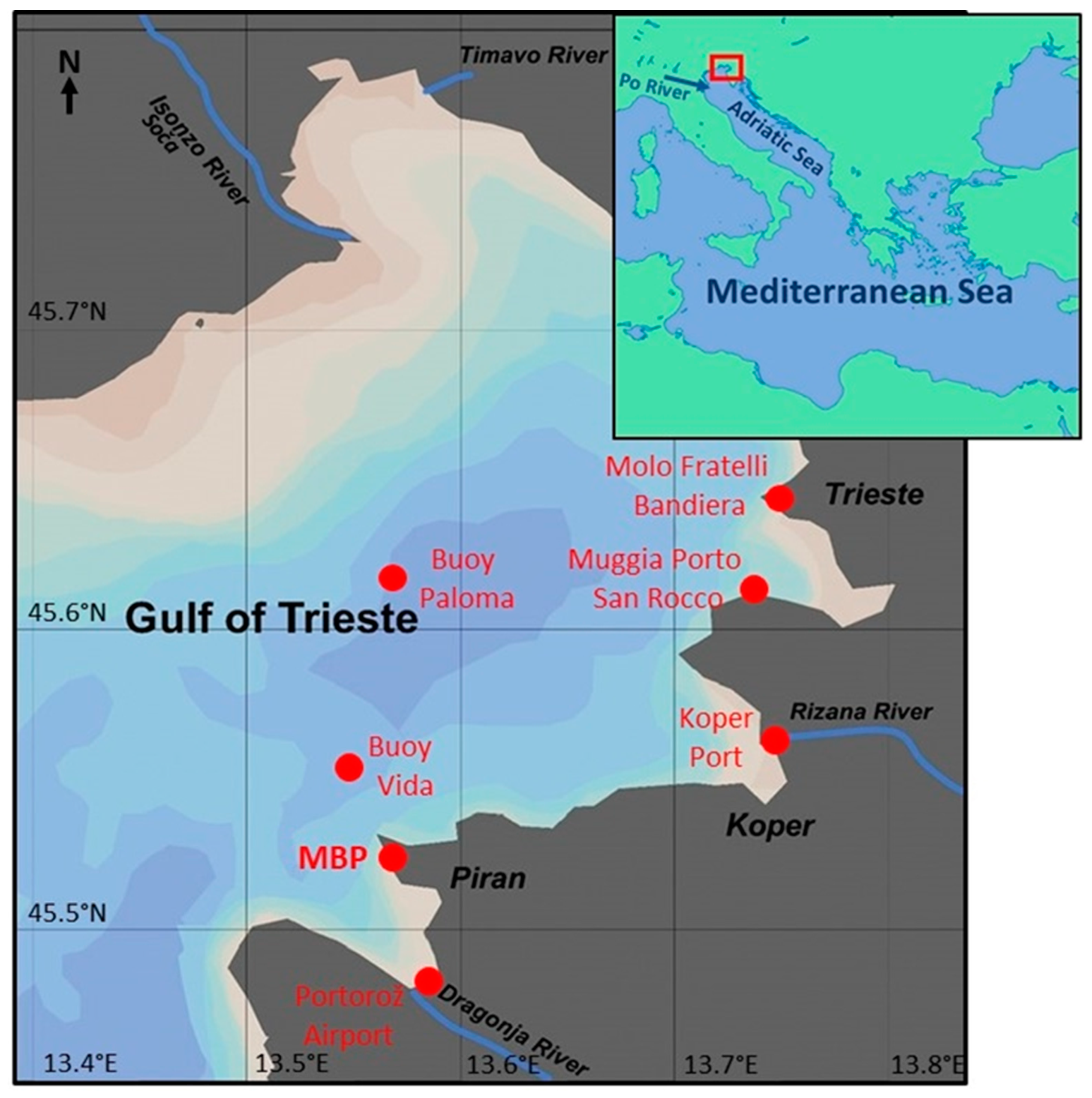

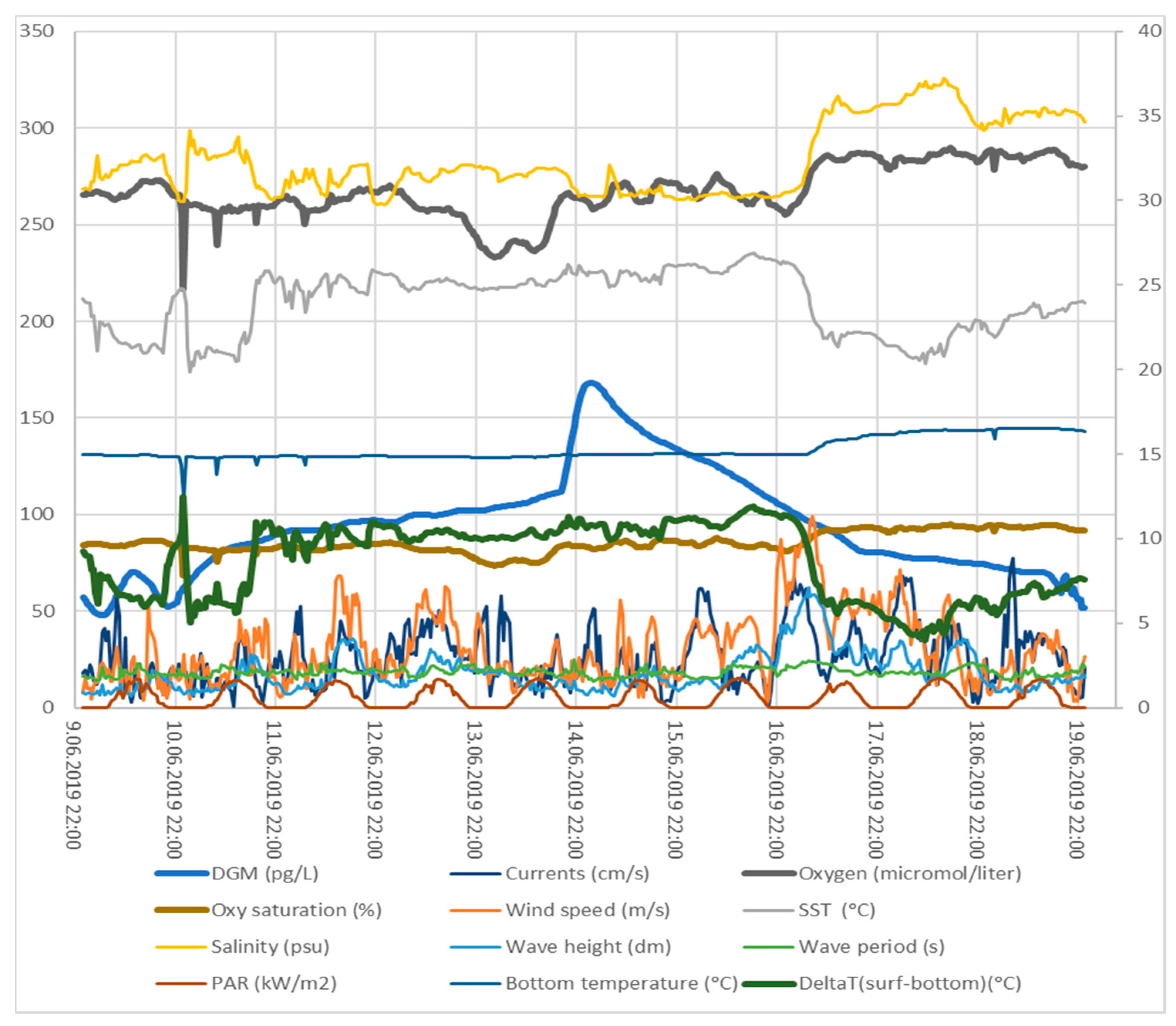

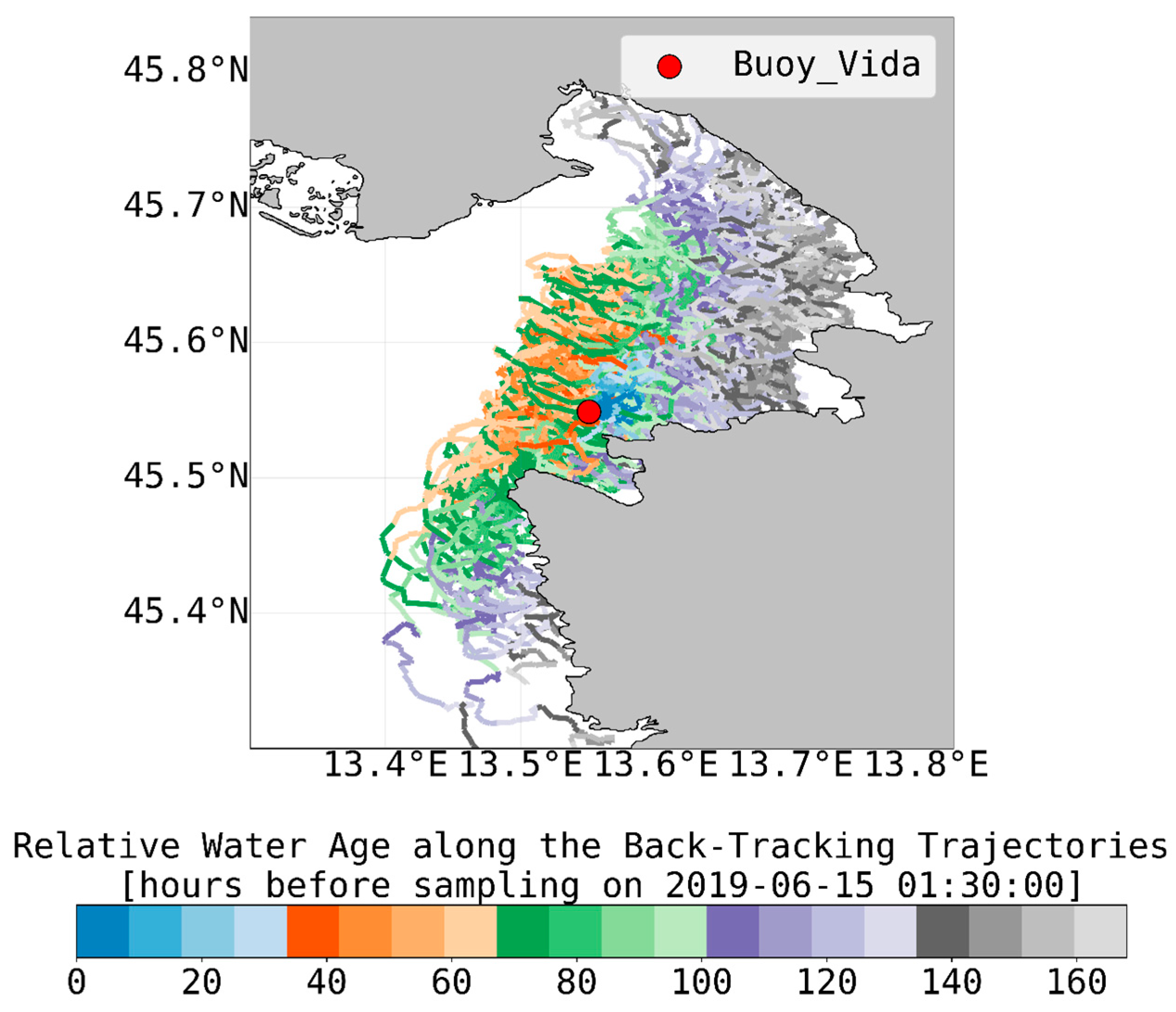
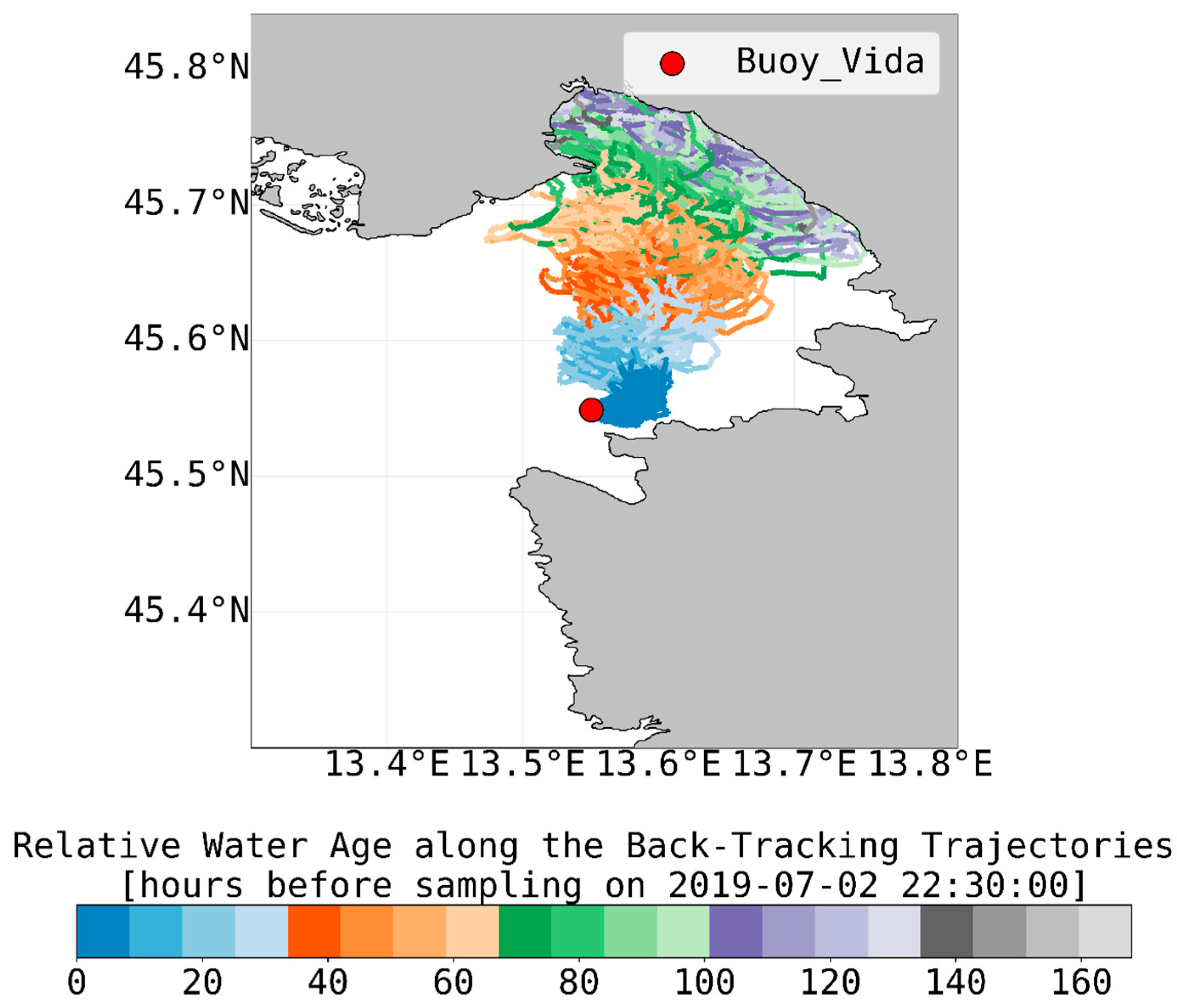
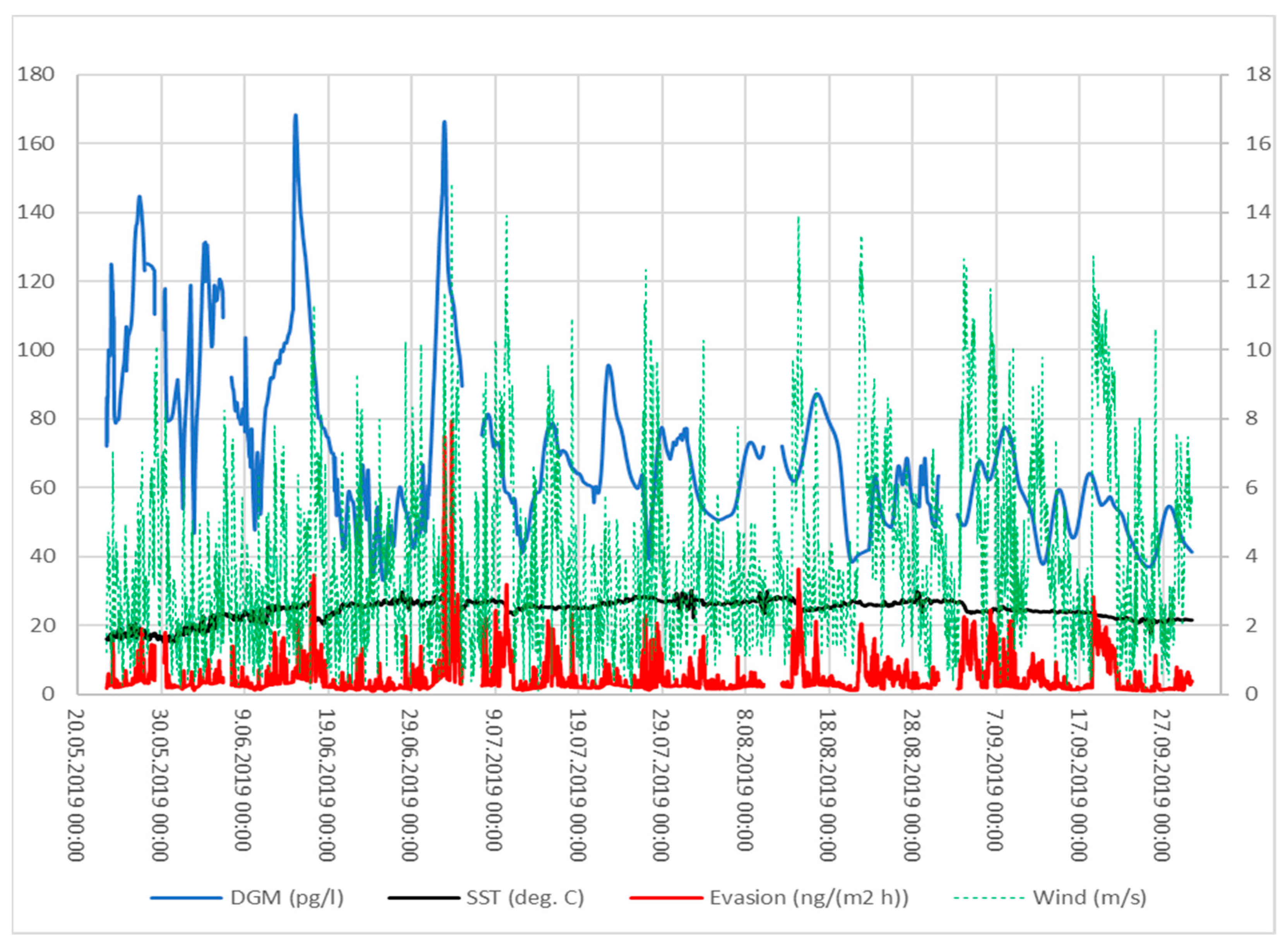
| Sampling Period | DGM (ng·m−3) | Diurnal Variation (ng·m−3) | Diurnal Max (@ UTC) (ng·m−3) | Diurnal Min (@ UTC) (ng·m−3) |
|---|---|---|---|---|
| 23 May–30 September | 68.7 ± 23.8 | 68.7 ± 0.26 | 69.2 (21:00–22:00) | 68.3 (03:00–04:00) |
| 23 May–4 July | 85.8 ± 31.0 | 85.8 ± 0.65 | 87.1 (23:00–24:00) | 84.8 (12:00–13:00) |
| 7 July–30 September | 60.1 ± 12.4 | 60.2 ± 0.13 | 60.4 (08:00–09:00) | 59.9 (15:00–16:00) |
| Method (Numerical Model) | Variables (Seasonal) | Variables (Real Time, Measured) | Wind Model | Diffusion Model | Mass of Evasion (kg·yr−1) | |
|---|---|---|---|---|---|---|
| Širca et al., 1999 [14] | estimation | - | - | - | - | 10 (1) |
| Andersson et al., 2007 [22]; Kotnik et al., 2015 [3] | Andersson et al., 2007 [22], measurements | - | TGM, DGM, SST, wind | [48] | [69] | 100 (2) |
| Ramšak et al., 2013 (1) [52] | Gårdfeldt et al., 2003 [35] | DGM, TGM, SST, deposition | Wind | [48] | [69] | 133 |
| Ramšak et al., 2013 (2) [52] | Gårdfeldt et al., 2003 [35] (PCFLOW3D) | TGM, SST, deposition | DGM, wind, bottom flux | [48] | [69] | 78 |
| Tomažič et al., 2018 [42] (extreme wind) | Andersson et al., 2007 [22] (AdriHg) | TGM, deposition | DGM, wind, SST | [48] | [49] | 26.4–34.0 (3) |
| Tomažič et al., 2018 [42] (decresed wind) | Andersson et al., 2007 [22] (AdriHg) | TGM, deposition | DGM, wind, SST | [48] | [49] | 16.1–21.1 (3) |
| Floreani et al., 2019 [44] | Measurements | - | flux | - | - | 163 (4) 137 (5) |
| This research | Andersson et al., 2007 [22] | TGM | DGM, wind, SST | [48] | [49] | 30 |
Publisher’s Note: MDPI stays neutral with regard to jurisdictional claims in published maps and institutional affiliations. |
© 2022 by the authors. Licensee MDPI, Basel, Switzerland. This article is an open access article distributed under the terms and conditions of the Creative Commons Attribution (CC BY) license (https://creativecommons.org/licenses/by/4.0/).
Share and Cite
Kotnik, J.; Žagar, D.; Novak, G.; Ličer, M.; Horvat, M. Dissolved Gaseous Mercury (DGM) in the Gulf of Trieste, Northern Adriatic Sea. J. Mar. Sci. Eng. 2022, 10, 587. https://doi.org/10.3390/jmse10050587
Kotnik J, Žagar D, Novak G, Ličer M, Horvat M. Dissolved Gaseous Mercury (DGM) in the Gulf of Trieste, Northern Adriatic Sea. Journal of Marine Science and Engineering. 2022; 10(5):587. https://doi.org/10.3390/jmse10050587
Chicago/Turabian StyleKotnik, Jože, Dušan Žagar, Gorazd Novak, Matjaž Ličer, and Milena Horvat. 2022. "Dissolved Gaseous Mercury (DGM) in the Gulf of Trieste, Northern Adriatic Sea" Journal of Marine Science and Engineering 10, no. 5: 587. https://doi.org/10.3390/jmse10050587
APA StyleKotnik, J., Žagar, D., Novak, G., Ličer, M., & Horvat, M. (2022). Dissolved Gaseous Mercury (DGM) in the Gulf of Trieste, Northern Adriatic Sea. Journal of Marine Science and Engineering, 10(5), 587. https://doi.org/10.3390/jmse10050587







